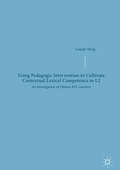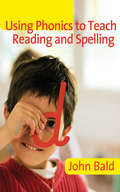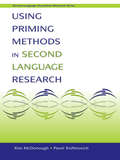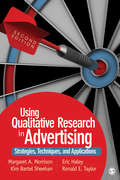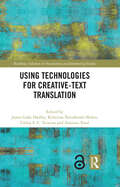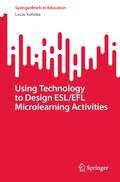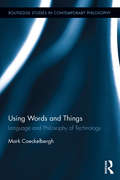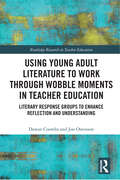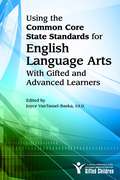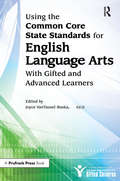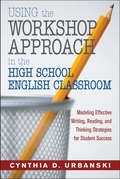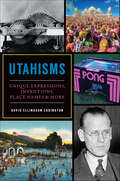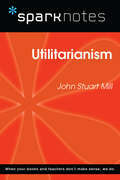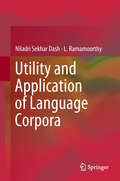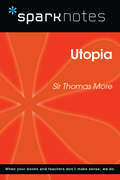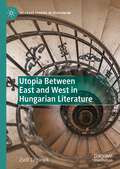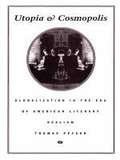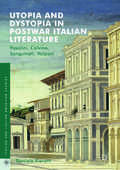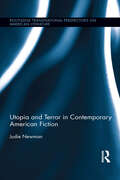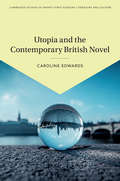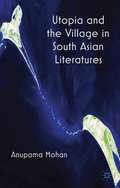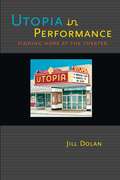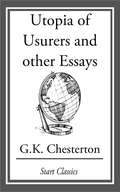- Table View
- List View
Using Pedagogic Intervention to Cultivate Contextual Lexical Competence in L2: An Investigation of Chinese EFL Learners
by Gaiyan WangThis book challenges prevailing linguistic presumptions concerning contextual lexical meaning by examining whether pedagogic intervention targeted at raising Chinese EFL learners’ awareness of the pragmatic nature of contextual lexical meaning can enhance the learners’ contextual lexical inferencing competence (CLIC). CLIC is crucial to the development of a learners’ vocabulary, reading ability and autonomy in reading. Through an empirical study conducted among a group of adult Chinese students of English, the author shows that the power of CLIC instruction lies mainly in its effectiveness in enhancing learners’ self-confidence in making lexical inferences. This book will be of interest to researchers and students of applied linguistics, TESOL, language education, and for language professionals keen to extend their research experience.
Using Phonics to Teach Reading & Spelling
by John BaldIncludes CD-Rom Times Educational Supplement Star Read! 'This is an authoritative yet lively and eminently readable book. It is well grounded in both the latest academic theory and experienced hands-on pedagogic practice, and it summarises succinctly the implications of the recent Rose Report, giving a masterly exposition of both synthetic and analytic phonics and their places in the processes of learning to read and spell. Practical and organisational issues are tackled in a most supportive way, with very useful checklists and photocopiable proformas on an accompanying CD. The book also provides and excellent guide to provision for professional development, involving the use of lesson observation and part of the evaluation and planning cycle for CPD. Its style is clear and well signposted with subheadings, case-study boxes to illuminate points, and with aims given at the start of each chapter as well as challenging points for reflection and guides to further reading at the ends. Every staff room should have one!' - Dorothy Latham, Primary Education Consultant, English specialist and author of How Children Learn to Write 'Synthetic phonics may well be only one tool for teaching reading and spelling, but it is the single most important one' - Ruth Kelly, Education Secretary, March 2006 'Teachers - and particularly Literacy Co-ordinators or SENCOs - who are enthusiastic about children's learning and about their own professional development will undoubtedly benefit from using this book and CD, with its combination of useful explanation and practical resources to support the implementation of the ideas' - Lorna Gardiner, General Adviser, Foundation Stage, North Eastern Education and Library Board, Northern Ireland Are you looking for practical advice on how to teach phonics? By giving the reader a basic introduction to teaching reading and spelling using phonics, this book will provide you with easy-to-use ideas for your classrooms. Following on from the recommendations of the Rose Report, the author explains why teaching phonics works, and how to present irregular as well as straightforward features of English. The book: o contains practical examples and activities for teachers o explains the basis of synthetic and analytic phonics o gives advice on choosing the best resources o looks at how to help the weakest readers o includes a CD Rom with photocopiable resources and INSET materials o contains a glossary of key terms Literacy Co-ordinators, teachers and teaching assistants will find this an invaluable resource.
Using Priming Methods in Second Language Research (Second Language Acquisition Research Series)
by Kim McDonough Pavel TrofimovichUsing Priming Methods in Second Language Research is an accessible introduction to the use of auditory, semantic, and syntactic priming methods for second language (L2) processing and acquisition research. It provides a guide for the use, design, and implementation of priming tasks and an overview of how to analyze and report priming research. Key principles about auditory, semantic, and syntactic priming are introduced, and issues for L2 researchers to consider when designing priming studies are pointed out. Empirical studies that have adopted priming methods are highlighted to illustrate the application of experimental techniques from psychology to L2 processing and acquisition research. Each chapter concludes with follow-up questions and activities that provide additional reinforcement of the chapter content, while the final chapter includes data sets that can be used to practice the statistical tests commonly used with priming data.
Using Qualitative Research in Advertising: Strategies, Techniques, and Applications (2nd Edition)
by Kim B. Sheehan Dr Margaret A. Morrison Dr Eric E. Haley Dr Ronald E. TaylorThis Second Edition remains the only book to discuss both theory and application of qualitative research techniques to inspire great advertising and build strong brands. Using a step-by-step approach created for students considering advertising careers and for those currently working in the advertising industry, this book explains what qualitative research techniques are designed to do. The text describes how these techniques aid in uncovering insights useful for advertising strategy development, creative development, and post-campaign evaluation. Practical information and discussions on interviewing, projective techniques, focus groups, and online/social media applications positioned within a theoretical context illustrate the value of qualitative research in the real world.
Using Talk to Support Writing
by Ros Fisher Shirley Larkin Debra Myhill Susan J. JonesUsing Talk to Support Writing presents a new and innovative approach to the teaching of early writing. The authors discuss both theoretical and practical issues around using talk in the classroom to support children as they learn to write. Set within the context of national concern for achievement in the development of writing ability, it addresses the gap in understanding early teaching and focuses on the exploration of how talk and writing interface. This includes: - Numerous examples of teaching and activities for using talk to support writing - Using extensive data from classrooms; video and audio recordings, and transcripts of children's talk - Exploring three aspects of talk when used to support writing: talk for idea generation; talk for oral rehearsal and talk for reflection. This book is for students on Primary ITT courses, particularly for English specialists. Students on M-level English and literacy courses will also find it useful.
Using Technologies for Creative-Text Translation (Routledge Advances in Translation and Interpreting Studies)
by James Luke Hadley Kristiina Taivalkoski-Shilov Antonio Toral Teixeira, Carlos S. C.This collection reflects on the state of the art of research into the use of translation technologies in the translation of creative texts, encompassing literary texts but also extending beyond to cultural texts, and charts their development and paths for further research. Bringing together perspectives from scholars across the discipline, the book considers recent trends and developments in technology that have spurred growing interest in the use of computer-aided translation (CAT) and machine translation (MT) tools in literary translation. Chapters examine the relationships between translators and these tools–the extent to which they already use such technologies, the challenges they face, and prevailing attitudes towards these tools–as well as the ethical implications of such technologies in translation practice. The volume gives special focus to drawing on examples with and beyond traditional literary genres to look to these technologies’ use in working with the larger group of creative texts, setting the stage for many future research opportunities. The book will be of particular interest to students and scholars in translation studies, especially those with an interest in literary translation, translation technology, translation practice, and translation ethics.
Using Technology to Design ESL/EFL Microlearning Activities (SpringerBriefs in Education)
by Lucas KohnkeThis book provides strategies, tools, and best practices for incorporating microlearning in English language teaching. It aims to help teachers create and deliver microlearning mechanisms that are optimized for mobile learning. This book also draws on relevant literature and the author’s first-hand experience designing microlearning activities for English learners. It covers important aspects of microlearning, including artificial intelligence, virtual reality, augmented reality, and mixed modalities. It is an important starting point for teachers, academics, and researchers interested in the principles and practice of microlearning in English language teaching. English language teachers in formal and informal education environments find this work thought-provoking, instructive, and informative and benefit from exploring the possibilities of microlearning to motivate and engage learners and maximize the number and quality of their learning experiences.
Using Words and Things: Language and Philosophy of Technology (Routledge Studies in Contemporary Philosophy)
by Mark CoeckelberghThis book offers a systematic framework for thinking about the relationship between language and technology and an argument for interweaving thinking about technology with thinking about language. The main claim of philosophy of technology—that technologies are not mere tools and artefacts not mere things, but crucially and significantly shape what we perceive, do, and are—is re-thought in a way that accounts for the role of language in human technological experiences and practices. Engaging with work by Wittgenstein, Heidegger, McLuhan, Searle, Ihde, Latour, Ricoeur, and many others, the author critically responds to, and constructs a synthesis of, three "extreme", idealtype, untenable positions: (1) only humans speak and neither language nor technologies speak, (2) only language speaks and neither humans nor technologies speak, and (3) only technology speaks and neither humans nor language speak. The construction of this synthesis goes hand in hand with a narrative about subjects and objects that become entangled and constitute one another. Using Words and Things thus draws in central discussions from other subdisciplines in philosophy, such as philosophy of language, epistemology, and metaphysics, to offer an original theory of the relationship between language and (philosophy of) technology centered on use, performance, and narrative, and taking a transcendental turn.
Using Young Adult Literature to Work through Wobble Moments in Teacher Education: Literary Response Groups to Enhance Reflection and Understanding (Routledge Research in Teacher Education)
by Dawan Coombs Jon OstensonThis volume offers a novel approach to exploring how literary response groups can be used as part of teacher education programs to help preservice teachers navigate "wobble" moments. Focusing uniquely on the potential of young adult literature (YAL), the text draws on the first-hand experiences of teacher candidates and uses a range of well-known books to demonstrate how narrative-based inquiry and analysis of fictional depictions of teaching and learning can support reflection on a range of common challenges. The volume presents how YAL literary response groups are shown to enhance participants’ ability to reflect on practice, build resilience, and develop deeper understanding of pedagogical principles by offering a shared dialogical space. These insights ultimately contribute to teacher education program improvement by enhancing teacher candidates’ understanding of pedagogy. This text will benefit researchers, doctoral students, and academics in the fields of teaching, teacher mentoring, and teacher education more specifically. Those interested in literature studies and young adult literature (YAL) more broadly will also benefit from this volume.
Using a Net
by Jessica QuiltyThe fun and excitement of English and Language Arts learning continues in Grade 2 of Reading Street. This comprehensive and dynamic curriculum for homeschooling is geared toward young children who have some foundational English and Language Arts knowledge and are ready to strengthen their skills. Comprised of engaging activities, challenging content and weekly quizzes, Reading Street: Grade 2 is the next step in your child's path toward becoming a lifelong learner and reader. As with all Reading Street products, the Grade 2 system is formatted to help students meet certain age-appropriate goals. After completing this English and Language Arts homeschool program, your child should be able to: Read and comprehend two-syllable words. Identify common prefixes (such as pre-, un-, or re-) and suffixes (such as -able, -ad and -er). Correct mistakes made when reading out loud. Read books with two or more chapters. Understand the structure of stores (i. e. beginning, middle and end). Start selecting reading materials based on his/her own interests. Identify the "who," "what," "when," "where," "why" and "how" of the text. While the goals of second Grade English and Language Arts are numerous, Reading Street will help you craft engrossing lessons. Your child will garner important English and Language Arts skills while completing a workbook, reading stories and poems, and taking assessments. Planning these lessons will be easier than ever, as all Reading Street systems are broken down into weekly Big Ideas. All the work your child does on a given week is formulated around that single concept for an organized and challenging curriculum. With six easy-to-follow units, Reading Street: Grade 2 is the perfect tool for homeschooling parents. Your child will enjoy the reading selections and activities, and you'll love to see your student growing into a knowledgeable individual. We're confident that this product is the right one for you. For more information on the specific materials found in Grade 2 of Reading Street, check out the Features and Benefits page.
Using the Common Core State Standards for English Language Arts With Gifted and Advanced Learners
by Joyce Vantassel-BaskaUsing the Common Core State Standards in English Language Arts With Gifted and Advanced Learners provides teachers and administrators examples and strategies to implement the new Common Core State Standards (CCSS) with advanced learners at all stages of development in K-12 schools. The book describes--and demonstrates with specific examples from the CCSS--what effective differentiated activities in English language arts look like for top learners. It shares how educators can provide both rigor and relevance within the new standards as they translate them into meaningful experiences for gifted and advanced learners.
Using the Common Core State Standards for English Language Arts With Gifted and Advanced Learners
by National Assoc For Gifted ChildrenUsing the Common Core State Standards for English Language Arts With Gifted and Advanced Learners provides teachers and administrators examples and strategies to implement the new Common Core State Standards (CCSS) with advanced learners at all stages of development in K-12 schools. The book describes—and demonstrates with specific examples from the CCSS—what effective differentiated activities in English language arts look like for top learners. It shares how educators can provide both rigor and relevance within the new standards as they translate them into meaningful experiences for gifted and advanced learners.
Using the Workshop Approach in the High School English Classroom: Modeling Effective Writing, Reading, and Thinking Strategies for Student Success
by Cynthia D. UrbanskiTake a peek into an effective workshop-based classroom and discover how you can enhance adolescents' technical and creative abilities in reading, writing, and thinking.
Utahisms: Unique Expressions, Inventions, Place Names & More
by David Ellingson EddingtonUtahisms: Unique Expressions, Inventions, Place Names and more ranges from the characteristic to the bizarreThe Beehive State's iconic vistas are singular and distinctive. So too are its colloquialisms, peculiar place names and landmark firsts. Confusion from local dialect ultimately thwarted a would be robber in Salt Lake City. The proper pronunciation of Tooele might surprise visitors, while residents still debate its origins. And, phrases once thought to be solely Utahn often prove otherwise. The world's first department store was born out of xenophobia and religious persecution in 1869. Martha Hughes Cannon followed through on Brigham Young's encouraging women to become physicians. She later became the first female state senator in the United States, defeating her own husband. Examining everything from phonetics to history, BYU Linguistics Professor David Eddington reveals the roots of what is truly, uniquely Utah.
Utilitarianism (SparkNotes Philosophy Guide)
by SparkNotesUtilitarianism (SparkNotes Philosophy Guide) Making the reading experience fun! SparkNotes Philosophy Guides are one-stop guides to the great works of philosophy–masterpieces that stand at the foundations of Western thought. Inside each Philosophy Guide you&’ll find insightful overviews of great philosophical works of the Western world.
Utility and Application of Language Corpora
by Niladri Sekhar Dash L. RamamoorthyThis book discusses some of the basic issues relating to corpus generation and the methods normally used to generate a corpus. Since corpus-related research goes beyond corpus generation, the book also addresses other major topics connected with the use and application of language corpora, namely, corpus readiness in the context of corpus sanitation and pre-editing of corpus texts; the application of statistical methods; and various text processing techniques. Importantly, it explores how corpora can be used as a primary or secondary resource in English language teaching, in creating dictionaries, in word sense disambiguation, in various language technologies, and in other branches of linguistics. Lastly, the book sheds light on the status quo of corpus generation in Indian languages and identifies current and future needs.Discussing various technical issues in the field in a lucid manner, providing extensive new diagrams and charts for easy comprehension, and using simplified English, the book is an ideal resource for non-native English readers. Written by academics with many years of experience teaching and researching corpus linguistics, its focus on Indian languages and on English corpora makes it applicable to graduate and postgraduate students of applied linguistics, computational linguistics and language processing in South Asia and across countries where English is spoken as a first or second language.
Utopia (SparkNotes Philosophy Guide)
by SparkNotesUtopia (SparkNotes Philosophy Guide) Making the reading experience fun! SparkNotes Philosophy Guides are one-stop guides to the great works of philosophy–masterpieces that stand at the foundations of Western thought. Inside each Philosophy Guide you&’ll find insightful overviews of great philosophical works of the Western world.
Utopia Between East and West in Hungarian Literature (Palgrave Studies in Utopianism)
by Zsolt CzigányikThis book focuses on the most important utopian and dystopian literary texts in nineteenth and twentieth-century Hungarian literature, and therefore widens the scope of the traditionally Anglophone canon. Utopian studies is becoming increasingly interdisciplinary, and this research integrates literary hermeneutics with ideas and methods from political science and the history of ideas. In doing so, it argues that Hungarian utopianism was influenced by the region’s (and Hungarian culture’s) position of permanent liminality between Western and Eastern European patterns of power structures, social and political order. After a thorough methodological introduction, some early modern texts written in Hungary are discussed, while the detailed analyses focus on nineteenth-century texts, written by Bessenyei, Madách, and Jókai, whereas the twentieth century is represented by Karinthy, Babits and Szathmári. In the interpretations the results of contemporary scholarship is applied, particularly the works of Lyman Tower Sargent, Gregory Claeys and Fátima Vieira.
Utopia and Cosmopolis: Globalization in the Era of American Literary Realism
by Thomas PeyserWhen did Americans first believe they were at the center of a truly global culture? How did they envision that culture and how much do recent attitudes toward globalization owe to their often utopian dreams? In Utopia and Cosmopolis Thomas Peyser asks these and other questions, offers a reevaluation of American literature and culture at the dawn of the twentieth century, and provides a new context for understanding contemporary debates about America's relation to the rest of the world. Applying current theoretical work on globalization to the writing of authors as diverse as Edward Bellamy, Charlotte Perkins Gilman, William Dean Howells, and Henry James, Peyser reveals the ways in which turn-of-the-century American writers struggled to understand the future in a newly emerging global community. Because the pressures of globalization at once fostered the formation of an American national culture and made national culture less viable as a source of identity, authors grappled to find a form of fiction that could accommodate the contradictions of their condition. Utopia and Cosmopolis unites utopian and realist narratives in subtle, startling ways through an examination of these writers' aspirations and anxieties. Whether exploring the first vision of a world brought together by the power of consumer culture, or showing how different cultures could be managed when reconceived as specimens in a museum, this book steadily extends the horizons within which late nineteenth- and early twentieth-century American literature and culture can be understood. Ranging widely over history, politics, philosophy, and literature, Utopia and Cosmopolis is an important contribution to debates about utopian thought, globalization, and American literature.
Utopia and Dystopia in Postwar Italian Literature
by Daniele FiorettiThis book is about the presence of utopian and dystopian elements in the Italian literary landscape. It focuses on four authors that are representatives of the various positions in the Italian cultural debate: Pasolini, Calvino, Sanguineti, and Volponi. What did concepts like utopia and dystopia mean for these authors? Is it possible to separate utopia from dystopia? What is the role of science fiction in this debate? This book answers these questions, proposing an original interpretation of utopia and of the social role of literature. The book also takes into consideration four of the most influential literary journals in Italy: Officina, il menab#65533;, il verri, and Nuovi Argomenti, that played a central role in the cultural and political debate on utopia in Italy.
Utopia and Terror in Contemporary American Fiction (Routledge Transnational Perspectives on American Literature #21)
by Judie NewmanThis book examines the quest for/failure of Utopia across a range of contemporary American/transnational fictions in relation to terror and globalization through authors such as Susan Choi, André Dubus, Dalia Sofer, and John Updike. While recent critical thinkers have reengaged with Utopia, the possibility of terror — whether state or non-state, external or homegrown — shadows Utopian imaginings. Terror and Utopia are linked in fiction through the exploration of the commodification of affect, a phenomenon of a globalized world in which feelings are managed, homogenized across cultures, exaggerated, or expunged according to a dominant model. Narrative approaches to the terrorist offer a means to investigate the ways in which fiction can resist commodification of affect, and maintain a reasoned but imaginative vision of possibilities for human community. Newman explores topics such as the first American bestseller with a Muslim protagonist, the links between writer and terrorist, the work of Iranian-Jewish Americans, and the relation of race and religion to Utopian thought.
Utopia and the Contemporary British Novel (Cambridge Studies in Twenty-First-Century Literature and Culture #3)
by Caroline EdwardsThis book examines the experience of time functions in a specific set of British novels to reveal the persistence of the utopian imagination in the twenty-first century. Through close textual analysis, Edwards develops a new strategy of reading such anticipatory 'fictions of the not yet', including novels by Hari Kunzru, Maggie Gee, David Mitchell, Ali Smith, Jim Crace, Joanna Kavenna, Grace McCleen, Jon McGregor, and Claire Fuller. Read in the context of the philosophical category of non-contemporaneity, these novels reveal a significant new direction in twenty-first-century fiction. Their formal inventiveness and suggestively non-mimetic encounters with otherwise realist narrative representations of contemporary experience open up a realm of utopian possibility that shines through in moments of temporal alterity: glimpses of the future, redeemed strands of past hopes, and alternative social worlds already alive in the present.
Utopia and the Village in South Asian Literatures
by Anupama MohanShifting the postcolonial focus away from the city and towards the village, this book examines the rural as a trope in twentieth-century South Asian literatures to propose a new literary history based on notions of utopia, dystopia, and heterotopia and how these ideas have circulated in the literary and the cultural imaginaries of the subcontinent.
Utopia in Performance
by Jill DolanLive performance can provide people with inspiration for an improved world, Dolan argues, one that seems to be slipping further away since 9/11. As examples, she analyzes autobiographical performances by feminists Holly Hughes, Peggy Shaw, and Deb Margolin; multiple- character monologues by Lily Tomlin, Danny Hoch, and Anna Deavere Smith; the political suggestions of Russell Simmons Def Poetry Jam on Broadway and The Laramie Project; and radical humanism in Ann Carlson's Blanket, Mary Zimmerman's Metamorphoses, and Deborah Warner and Fiona Shaw's Medea. Annotation ©2006 Book News, Inc. , Portland, OR (booknews. com)
Utopia of Usurers and other Essays
by G. K. ChestertonWhat is it that angers Chesterton and fills him with grim forebodings for the future of his island? Many things and, especially, many persons. But chiefly the capitalists, the upper middle class, the usurers, or however they be termed, and the fear of the servile state, the state in which art and literature and science and efficiency and morality and everything else that has value in the eyes of mortal man become the humble servants of the money-changers, in short, the "utopia of usurers." --The Dial, 1918.
